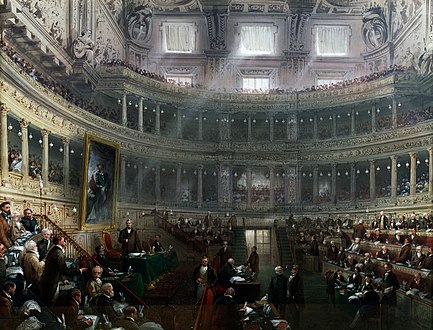Carlo Bossoli
This article needs additional citations for verification. (September 2015) |
Carlo Bossoli | |
|---|---|
 Carlo Bossoli, Self-portrait, date unknown | |
| Born | 6 December 1815 |
| Died | 1 August 1884 |
| Nationality | Swiss |
| Education | Order of Friars Minor Capuchin |
| Known for | Painter |
| Movement | Orientalist |
Carlo Bossoli (6 December 1815, in Lugano – 1 August 1884, in Turin)[1] was a Swiss-born Italian painter and lithographer, who spent his early career in Ukraine. He is best known for historical scenes from the Risorgimento.
Biography
[edit]
His father was a stonemason of Italian origin, working in Switzerland. In 1820, his family moved to accept work in Odesa.[2] Until 1826, he studied with the Capuchins. After graduating, he worked in a shop that sold antiquarian books and prints. It was there that he began to draw and sketch.[3] In 1828, he was hired by the Odesa Opera to work as an assistant to Rinaldo Nannini,[2] a stage designer who had studied at La Scala under Alessandro Sanquirico. He began to sell his paintings in 1833. His father died three years later and he found himself the sole support of his mother, his sister and her illegitimate son.[citation needed]
Luckily, his work drew the attention of Prince Mikhail Vorontsov, who commissioned him to paint several views of Odesa. Princess Elizabeta was impressed with his abilities and arranged for him to study in Italy from 1839 to 1840.[2] He stayed mostly in Naples and Rome, giving special attention to tempera and gouache and associating with the many British artists who were living there. He returned in 1840 and settled in the coastal resort of Alupka, on the Vorontsov estate.
In 1844, at the request of his mother (who was ill), he moved to Milan and opened a studio there.[2] In 1848, he produced popular scenes from "Five Days of Milan". His mother died the following year, but he remained there until 1853, when an unsuccessful uprising against the Austrians forced him to flee to Turin, which he used as his base of operations for travels to England, France, Spain, Morocco, Germany and Scandinavia.
During those years, he produced an album of paintings, showing views of Crimea and customs of Crimean Tatars, which was published in London by Vincent Brooks, Day & Son. It proved to be very popular due to public interest in the Crimean War.[2] Later, in 1859, they commissioned him to produce a series of lithographs depicting the Second Italian War of Independence which were published as "The War in Italy".[4]
After seeing them, young Prince Oddone, Duke of Montferrat gave him a commission to follow the Piedmontese Army and make a record of its campaigns. The result was an album of 150 tempera paintings and the Prince declared him to be "the painter of our history". He fell ill with a fever at this time and his productivity declined dramatically. He divided his time between decorating his home to resemble the Vorontsov Palace and doting on his nephew.[2]
In 1883, at the age of sixty-eight, he married Adelaide De Carolis, who was only twenty-one. The marriage was generally believed to be a financial arrangement.[citation needed] The following year, he died of a heart attack. He was buried in Lugano and a street in Turin is named after him.
Selected paintings
[edit]-
The Senate of the Kingdom of Sardinia in the Palazzo Madama, presided over
by Cesare Alfieri di Sostegno (1860) -
The Armory of the Ubaldo family; raided by revolutionaries. (1848)
-
The Battle of Solferino (1859)
See also
[edit]References
[edit]- ^ Cipolla (2013). Il sogno di Garibaldi. Oltre Terracina, contro i Borboni: Oltre Terracina, contro i Borboni. FrancoAngeli. p. 149. ISBN 978-88-204-4813-4.
- ^ a b c d e f Brief biography at the Carlo Bossoni website (in Russian)
- ^ Manuela Kahn-Rossi (1994). Cantonal art museum, Lugano. Swiss Institute for Art Research. ISBN 9783908184270.
- ^ A Collection of new Books ... comprising valuable works in general literature, etc. Willis and Sotheran. 1861. p. 4.
Further reading
[edit]- Ugo Donati; La guerra del Cinquantanove nei disegni di Carlo Bossoli, 1815 - 1884, pittore ticinese, Banco di Roma per la Svizzera, 1959
- Cinquant'anni di vita europea nei disegni e nei dipinti di Carlo Bossoli (exhibition catalog) Tipografia Torinese, 1974
- Rosanna Maggio Serra and Ada Peyrot; Carlo Bossoli: cronache pittoriche del Risorgimento (exhibition catalog) Museo Nazionale del Risorgimento Italiano, 1985
- Cristina Vernizzi; Carlo Bossoli: cronache pittoriche del Risorgimento (1859-1861) nella Collezione di Eugenio di Savoia, Principe di Carignano, Artema, 1998 ISBN 88-8052-010-5
External links
[edit]- The War in Italy, Day & Son (1859), full text @ Google Books
- Carlo Bossoli @ Artisti Ticinesi: Biography with more paintings.
- Brief biography and more paintings @ Libero
- 1815 births
- 1884 deaths
- 19th-century Italian painters
- 19th-century Swiss painters
- 19th-century Italian male artists
- Swiss male painters
- Italian history painters
- Italian landscape painters
- Italian lithographers
- Italian male painters
- Italian unification
- Italian Orientalist painters
- Artists from Lugano
- Swiss-Italian people
- Swiss emigrants to the Russian Empire
- 19th-century Swiss male artists



